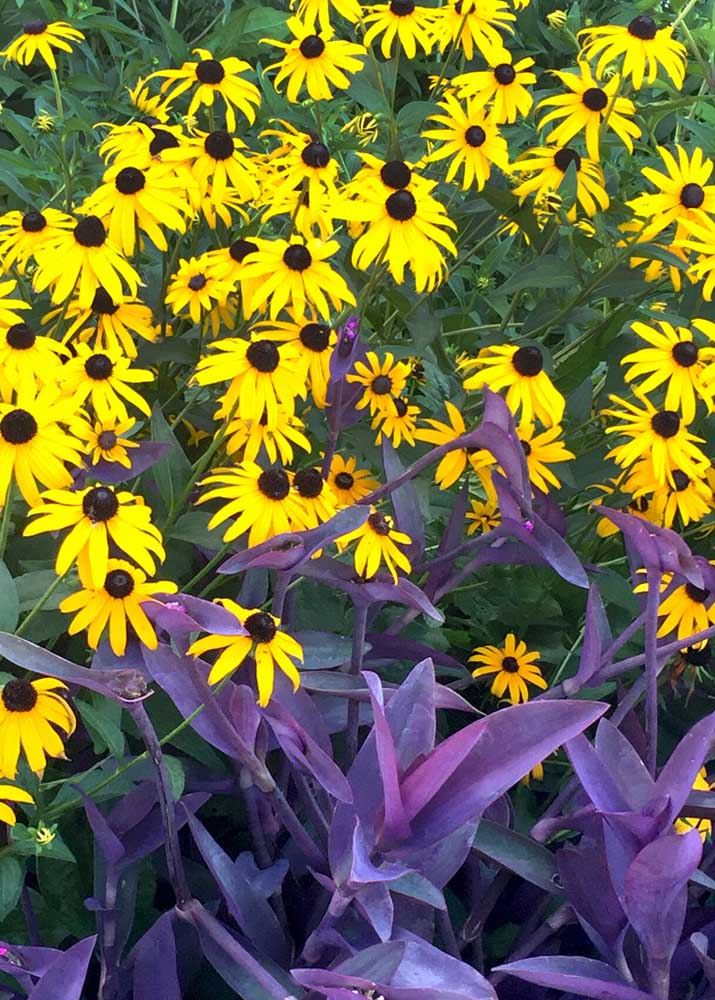Sperry: Keeping lawns healthy and the struggle of geraniums in Texas
Published 5:00 am Saturday, June 1, 2024

- Purpleheart groundcover is lovely with Goldsturm gloriosa daisies. (Contributed Photo)
Dear Neil: How can I eliminate speargrass and weedy grass roots from my St. Augustine?
Speargrass (Nassella leucotricha) is a Texas native plant. I’m a longtime Native Texas who grew up playing war games with speargrass seeds just like any other young boy. I also know it’s nothing you want to have around your home lawn. However, I don’t get many questions about it in St. Augustine lawns. It’s a cool-season perennial grass that does its growing while your St. Augustine is dormant. It grows best in “disturbed” soil, so do whatever you can to thicken up the St. Augustine this growing season so that it can crowd out the speargrass or needlegrass. If you have a tenacious stand of it in one particular part of your yard you could spray it with a glyphosate-only weedkiller (no other active ingredients included with the spray). Glyphosates are great at killing all grasses, and they do not contaminate the soil as long as you buy a product that contains no other herbicides blended in with the glyphosate. You could replant new St. Augustine into those areas within just a few days.
Trending
As for the “weedy grass roots,” I’m going to have to defer that question to a local independent certified nursery professional or feed store. It depends on what types of grasses are involved. Well maintained turf will usually crowd them out so that they will die off.
Dear Neil: We had had St. Augustine for 27 years, but had it replaced with bermuda sod two months ago. They treated for grubs before laying the new grass, but now we see these brown spots. It looked gorgeous, and we’ve had ample rain to be sure. Help!
This certainly looks like spring dead spot, a fungal disease that attacks bermuda turf. It’s been around many years, but it seems to be getting worse in recent decades. You’ll see good writeups online from Oklahoma State, Clemson, and several other southern ag colleges. They will alert you that it’s difficult to stop with fungicides and that you need to let the grass go without nitrogen after mid-September. Be careful not to allow thatch to form, as the disease seems to be more prevalent when thatch develops. It’s a bit unusual for this to show up so quickly on new turf. Talk to the folks who planted it for you to see if they have suggestions. If you need to have the disease identified for certain, send a sample to the Texas A&M Plant Disease Diagnostic Laboratory in College Station. They have complete instructions on their website.
Dear Neil: I planted a crape myrtle out from our front door. I didn’t realize at the time that our oak tree was going to shade it quite so much, and the crape myrtle never has bloomed very well. It gets about 5 hours of afternoon sun. Is that the problem?
Yes. You may even be able to see it growing away from the shadows and toward the light. That would further confirm your suspicion. I did about the same thing 40 years ago when I planted a Catawba crape myrtle on the south side of several native pecans. A larger Shumard red oak across the driveway further pinched the crape myrtle in place until it grew more than 20 feet tall and only 8 or 9 feet wide. (Catawba is normally shorter and wider.) I hired a couple of guys, and we three successfully moved that plant to a spot with full sunlight. It has thrived ever since. You might consider doing the same. A tree-form holly would serve you better in the shaded location.
Dear Neil: How is purpleheart propagated? I would normally use cuttings for its sisters, the wandering Jews, but since it’s a perennial, should I dig and divide it?
Trending
Use cuttings, especially since they’re so widely available at this time of year. They root easily and they’ll have ample time to develop good roots in their 4-inch pots, then become established out in the beds before fall. What a great plant. It’s great that you’re growing it.
Dear Neil: I can never get my geraniums to look like much as we go into the summer. Is there a secret? I used to have so much success when I grew them in Illinois.
Geraniums are mainstay summer color plants in the Midwest. When my wife and I were first married I taught horticulture 40 miles south of Lake Erie, and geraniums were a big part of my summertime landscape. But I grew up in Texas, and I came back to Texas. Our luck with geraniums is just as you reported. They don’t do well in the heat. You can grow them in pots and move them into more shade, but they get leggy, and they don’t bloom as well, so that’s a loss of a different type. Or you can watch them struggle and turn yellow out in the sun. I still grow them, but I buy a few very early each spring, grow them in pots so I can enjoy them to the maximum, and move them out of the hot sun as long as possible and then, many years, help them survive July and August to rebound in fall’s cooler temperatures.






